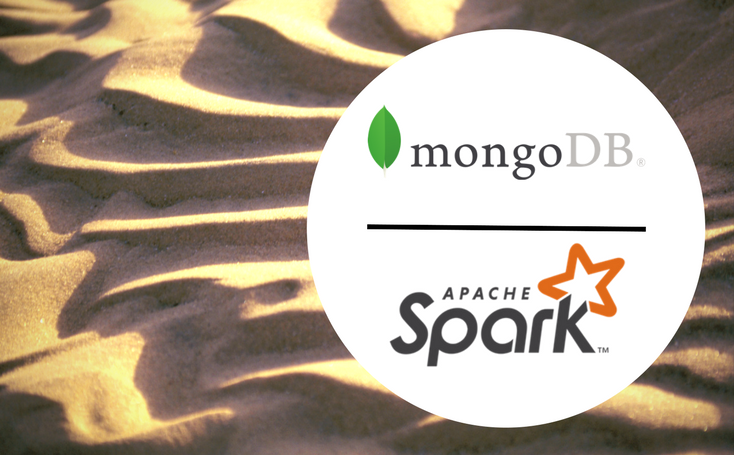MongoDB and Apache Spark are two popular Big Data technologies.
In my previous post, I listed the capabilities of the MongoDB connector for Spark. In this tutorial, I will show you how to configure Spark to connect to MongoDB, load data, and write queries.
To demonstrate how to use Spark with MongoDB, I will use the zip codes from MongoDB tutorial on the aggregation pipeline documentation using a zip code data set. I have prepared a Maven project and a Docker Compose file to get you started quickly.
Prerequisites
- Install Docker and Docker Compose
- Install Maven
- Download the project from Github
From the project root, launch the MongoDB server with docker-compose:
docker-compose -f docker/docker-compose.yml up -d
Import the data in the MongoDB database running in the container:
docker exec -it mongo_container sh /scripts/import-data.sh
Check that the data has been loaded in MongoDB by connecting to the container and running a count:
docker exec mongo_container mongo --eval "db.zips.count()"
This should return:
MongoDB shell version: 3.2.11
connecting to: test
29353
The zips collection is a collection of Document with the following model:
{
"_id": "10280",
"city": "NEW YORK",
"state": "NY",
"pop": 5574,
"loc": [
-74.016323,
40.710537
]
}
Import the Maven project in your favorite IDE. Create a new file Main.scala to copy the examples or run the MongoSparkMain for the solution.
Read data from MongoDB to Spark
In this example, we will see how to configure the connector and read from a MongoDB collection to a DataFrame.
First, you need to create a minimal SparkContext, and then to configure the ReadConfig instance used by the connector with the MongoDB URL, the name of the database and the collection to load:
import com.mongodb.spark._
import com.mongodb.spark.config.ReadConfig
import com.mongodb.spark.sql._
import com.typesafe.scalalogging.slf4j.LazyLogging
import org.apache.spark.sql.SparkSession
import org.apache.spark.sql.functions.{max, min}
import org.bson.Document
object Main extends App with LazyLogging {
val spark = SparkSession.builder()
.appName("mongozips")
.master("local[*]")
.getOrCreate()
// Read the data from MongoDB to a DataFrame
val readConfig = ReadConfig(Map("uri" -> "mongodb://127.0.0.1/", "database" -> "test", "collection" -> "zips")) // 1)
val zipDf = spark.read.mongo(readConfig) // 2)
zipDf.printSchema() // 3)
zipDf.show()
}
- Set the MongoDB URL, database, and collection to read.
- The connector provides a method to convert a MongoRDD to a DataFrame. The DataFrame’s schema is automatically inferred by the connector by sampling the collection. Alternatively, you can explicitly pass a schema definition.
- Print the schema inferred by the connector.
Results:
root
|-- _id: string (nullable = true)
|-- city: string (nullable = true)
|-- loc: array (nullable = true)
| |-- element: double (containsNull = true)
|-- pop: integer (nullable = true)
|-- state: string (nullable = true)
+-----+-----------+--------------------+-----+-----+
| _id| city| loc| pop|state|
+-----+-----------+--------------------+-----+-----+
|01001| AGAWAM|[-72.622739, 42.0...|15338| MA|
|01002| CUSHMAN|[-72.51565, 42.37...|36963| MA|
|01005| BARRE|[-72.108354, 42.4...| 4546| MA|
|01007|BELCHERTOWN|[-72.410953, 42.2...|10579| MA|
|01008| BLANDFORD|[-72.936114, 42.1...| 1240| MA|
+-----+-----------+--------------------+-----+-----+
only showing top 5 rows
The connector has correctly inferred the schema based on the documents sampling. Both the column names and types have been identified accurately.
Inferring inner-documents
Interestingly, the loc array from the MongoDB document has been translated to a Spark’s Array type.
But what if the document contains inner documents? The connector does not flatten the inner document but translates them as a Spark’s StructType, a key-value type.
Take for example this MongoDB document:
{
name: "Joe Bookreader",
country: {
isocode: "USA",
name: "United States"
},
addresses: [
{
street: "123 Fake Street",
city: "Faketon",
state: "MA",
zip: "12345"
}
]
}
The document has two inner documents. The first one is the country and the second one is an address contained in a list.
After loading the collections, the schema inferred by the connector shows a StructType for both the country and the address in the array of addresses.
val personDf = spark.read.mongo(ReadConfig(Map("uri" -> "mongodb://127.0.0.1/", "database" -> "test", "collection" -> "person")))
personDf.printSchema()
Results:
root
|-- _id: struct (nullable = true)
| |-- oid: string (nullable = true)
|-- addresses: array (nullable = true)
| |-- element: struct (containsNull = true)
| | |-- street: string (nullable = true)
| | |-- city: string (nullable = true)
| | |-- state: string (nullable = true)
| | |-- zip: string (nullable = true)
|-- country: struct (nullable = true)
| |-- isocode: string (nullable = true)
| |-- name: string (nullable = true)
|-- name: string (nullable = true)
The values in the StructType types can be accessed by their column names:
personDf.select($"_id", $"addresses"(0)("street"), $"country"("name"))
You can find the list of the mappings between the MongoDB types and the DataFrame’s types in the connector's documentation.
Use the Spark API to query the data
After loading the collection in a DataFrame, we can now use the Spark API to query and transform the data.
As an example, we write a query to find the states with a population greater or equal to 10 million. The example also shows how the Spark API can easily map to the original MongoDB query.
The MongoDB query is:
db.zipcodes.aggregate( [
{ $group: { _id: "$state", totalPop: { $sum: "$pop" } } },
{ $match: { totalPop: { $gte: 10*1000*1000 } } }
] )
And now the Spark query:
println( "States with Populations above 10 Million" )
import zipDf.sqlContext.implicits._ // 1)
zipDf.groupBy("state")
.sum("pop")
.withColumnRenamed("sum(pop)", "count") // 2)
.filter($"count" > 10000000)
.show()
Result:
States with Populations above 10 Millions:
+-----+--------+
|state| count|
+-----+--------+
| TX|16984601|
| NY|17990402|
| OH|10846517|
| IL|11427576|
| CA|29754890|
| PA|11881643|
| FL|12686644|
+-----+--------+
The DataFrame API is pretty straight forward for this simple query.
- Use the import to have implicit conversions from
StringtoColumnwith the$. - Rename the result of the sum column for readability.
Spark SQL
Spark and the DataFrame abstraction also enables to write plain Spark SQL queries with a familiar SQL syntax.
For example, let’s rewrite the previous query with SQL:
// SparkSQL:
zipDf.createOrReplaceTempView("zips") // 1)
zipDf.sqlContext.sql( // 2)
"""SELECT state, sum(pop) AS count
FROM zips
GROUP BY state
HAVING sum(pop) > 10000000"""
)
.show()
- Register the DataFrame as a Spark SQL table.
- Execute the Spark SQL query.
Predicates pushdown
“Predicates pushdown” is an optimization from the connector and the Catalyst optimizer to automatically “push down” predicates to the data nodes. The goal is to maximize the amount of data filtered out on the data storage side before loading it into Spark’s node memory.
There are two kinds of predicates automatically pushed down by the connector to MongoDB:
- the
selectclause (projections) as a$project - the
filterclause content (where) as one or more$match
Both are sent by the connector as an aggregation pipeline.
To verify if the predicates are sent, we use the Spark’s explain method to examine the query plan produced by Spark for a simple query with a filter:
zipDf
.filter($"pop" > 0)
.select("state")
.explain(true)
Output:
== Parsed Logical Plan ==
[...]
== Analyzed Logical Plan ==
[...]
== Optimized Logical Plan ==
[...]
== Physical Plan ==
*Project [state#4]
+- *Filter (isnotnull(pop#3) && (pop#3 > 0))
+- *Scan MongoRelation(MongoRDD[0] at RDD at MongoRDD.scala:52,Some(StructType(StructField(_id,StringType,true), StructField(city,StringType,true), StructField(loc,ArrayType(DoubleType,true),true), StructField(pop,IntegerType,true), StructField(state,StringType,true)))) [state#4,pop#3] PushedFilters: [IsNotNull(pop), GreaterThan(pop,0)], ReadSchema: struct<state:string>
We can see in the physical plan generated by the Catalyst optimizer, the name of the fields to project (state and pop), and the filters to push (pop not null and pop greater than 0).
To confirm what is actually executed on the MongoDB nodes, we need to increase MongoDB’s log level and examine the system.profile collection.
Enable the logging on MongoDB, run the Spark query again, and find the trace of the query in the system.profile collection:
$mongo
MongoDB shell version: 3.2.11
connecting to: test
> db.setProfilingLevel(2)
> db.system.profile.find().pretty()
The result is:
{
"op" : "command",
"ns" : "test.zips",
"command" : {
"aggregate" : "zips",
"pipeline" : [
{
"$match" : {
"_id" : {
"$gte" : { "$minKey" : 1 },
"$lt" : { "$maxKey" : 1 }
}
}
},
{
"$match" : {
"pop" : {
"$exists" : true,
"$ne" : null,
"$gt" : 0
}
}
},
{
"$project" : {
"state" : 1,
"pop" : 1,
"_id" : 0
}
}
],
"cursor" : {
},
"allowDiskUse" : true
},
[...]
}
The result shows the $project and $match clauses executed by MongoDB and, as expected, they match the Spark’s physical plan.
Conclusion
In this article, I have shown how to connect to a MongoDB database with Apache Spark to load and query the data. The connector provides a set of utility methods to easily load data from MongoDB to a DataFrame.
I have also presented how a MongoDB Document is mapped to a Spark’s DataFrame. Because of the hierarchical nature of a Document, only the first level of attributes is mapped to columns. Inner documents become nested columns.
Finally, I have described how the connector minimizes the data loaded in Spark by taking advantage of the predicates pushdown optimization, an essential feature of every connector. The connector does a good job of sending the predicates automatically, but it is helpful to know how to confirm if and how the predicates are applied on the MongoDB side.
In conclusion, the connector is fully functional to take benefit from using Spark on top of MongoDB.



